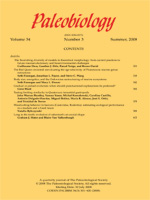One of the most extensively studied aspects of phylogenetic tree shape is balance, which is the extent to which nodes divide a tree into clades of equal size. Several authors have stressed the importance of tree balance for understanding patterns of evolution. It has been remarked that paleontological studies commonly produce very unbalanced trees (also called pectinate cladograms or “Hennigian combs”). This claim is tested here by comparing the balance of 50 paleontological trees and 50 neontological trees, all taken from the recent literature. Each tree was reanalyzed from the published data matrix to ensure its accuracy. The results confirm that paleontological trees tend to be more imbalanced than neontological trees.
That paleontological trees are more imbalanced has been represented as a shortcoming of fossil data sets, but here it is argued that this is the expected result. Even under a simple Markovian model in which all speciations and extinctions occur randomly and with equal probability in all parts of the tree, trees based on taxa from a single time period (e.g., the present day) are generally more balanced than trees based on all taxa that ever existed within the clade. Computer simulation is used to calculate the expected balance and standard deviation of trees for up to 40 terminal taxa over the entire history of a model clade. The balance is measured using Colless's index, Ic, and the expected balance conforms well with published paleontological trees. The study underlines the difficulty of applying neontological tree statistics in paleontology.





